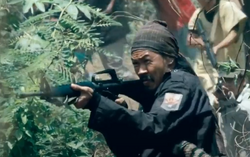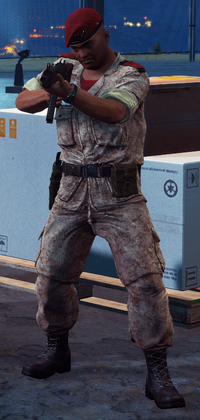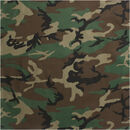Military as an aesthetic mainly centers around fashion and visuals associated with the military. While Military wear has also been popular among among self-proclaimed patriots with nationalistic ideals, many into the aesthetic simply enjoy its looks.
The flip side of Military aesthetic is Paramilitary, also known as SWATcore, SWATpunk etc. This is not exactly a form of Military aesthetic but similar in a nutshell and is found in LE agencies, security guards and various government agencies, SWAT teams the most common.
The military aesthetic is related to the Japanese gakuran, a male school uniform adopted from European military uniforms.
Visuals[]
- Camouflage
- Military uniforms
- Military vehicles/dispatch motorbikes etc
- Trenches
- Bunkers
- Weaponry, including hand grenades, knives and guns
- Recruitment and/or propaganda posters
- Flags
Fashion[]
- Uniform
- Modern militaries tend to have a variety of uniforms for different occasions.[1]
- Historical uniforms are also featured in this aesthetic.
- Practical clothing (field gear)
Media[]
Literature[]
- Battle Dress by Amy Efaw
- Inside Delta Force by Eric L. Haney
- Rites of Passage by Joy N. Hensley
- The Guerrilla Factory by Tony Schwalm
- The Red Circle by Brandon Webb
Anime[]
- 86
- 07-Ghost
- Alderamin on the Sky
- Gate
- Girls and Panzer
- Gunslinger Girl
- Heavy Object
- Joker Game
- Kantai Collection
- Sword Art Online Alternative: Gun Gale Online
- The Saga of Tanya the Evil
- Valkyria Chronicles
- Legend of Galactic Heroes
Video Games[]
Games that have the military aesthetic are primarily FPS (First-Person Shooters) or war simulators, but some strategy games are also related.
- Age of Empires
- Arma 3
- Call of Duty
- Company of Heroes
- Day of Infamy
- Hearts of Iron IV
- Men of War
- Metal Gear
- Nam
- PUBG: Battlegrounds
- Rising Storm
- Ultimate General: Civil War
- Verdun
- War Thunder
- World of Tanks
- World of Warships
Music[]
Military music typically includes marches and songs related to a country or its military, such as national anthems. However, music can have military themes without being explicitly related to a country. There's more to this than nationalism. For example, songs that focus on life in the military or war would fit this aesthetic.
Marches[]
- Blaze Away (Abe Holzmann)
- March Grandioso (Roland Seitz)
- Himno de la Brigada de Fusileros Paracaidistas
- March of the Defenders of Moscow
- Prussia's Glory
- The Thunderer (Sousa)
- The Washington Post (Sousa)
- The Rifle Regiment (Sousa)
- The Sword March
- World Beater by Andy Clark (Mostly Associated with the 1980s)
Country-specific Music[]
United States of America[]
- Ballad of The Green Beret
- The Stars and Stripes Forever (Sousa)
- The Warrior Song - Leviathan
- Battle Hymn of the Republic
- The Star-Spangled Banner
- US Navy SEAL cadence
United Kingdom[]
- A Bridge Too Far
- Lillibullero
- Brothers in Arms by Dire Straits
- The British Grenadiers
- Men of Harlech
Songs with Military Themes[]
- Soldier by Fleurie
- Phantom by Chizh
- Feuer frei! by Rammstein
- For Whom the Bell Tolls by Metallica
- Basically the entirety of Sabaton discography
- Fortunate Son by Creedence Clearwater Revival
Subgenres[]
Rambo[]
A Rambo character is a lone wolf who acts recklessly. The name originated from the 1982 movie First Blood where a character named John Rambo fights tons of enemies on his own.
Visuals[]
The aesthetics typically feature the character, usually topless/wearing a vest (female rambo characters with camouflage bikinis etc) holding a heavy weapon while wearing a belt of bullets across his/her chest.
Notable examples[]
- Various Rambo movies of the 1980s, typically seedy knock offs
- Mankillers (1987)
- Invasion Force (1990)
- Jungle Assault (1989)
- Rapid Fire (1989)
- Nightwars
- Operation War Zone
- Killzone (1985)
Revolution[]
Revolution specifically focuses on the buildup to a revolution, typically one that involves the military. Nationalism and a desire for change are particularly important for this subgenre.
In terms of aesthetics, the Revolution subgenre generally consists of two main factions with contrasting factions; the rebels, or otherwise the party that is attempting to overthrow or usurp the power of the second faction; the government- or another entity with supreme authority, in some cases represented by a monolithic corporation or even a larger rebel group encompassing that of the protagonist.
Rebels[]

Scene from Rambo (2008) featuring Karen National Liberation Army rebel soldiers.
The rebel faction will typically dress its 'soldiers' haphazardly and as such most of the rebels themselves will be wearing clothing and gear resembling that worn by civilians, with actual military equipment such as ammo pouches, webbing, helmets or field caps issued inconsistently amongst their ranks. In terms of appearances, rebels thus only vaguely, if at all, resemble foot soldiers of a contemporary military.

Rebel from the 2008 'Rambo' with a KNLA patch on their shoulder. As can be seen, he otherwise possesses no obvious military uniform or equipment.
The rebels that appear in the 2008 rendition of 'Rambo' appear to demonstrate most of the aesthetic trends used by 'rebel' factions in media quite well. Of the column of rebels visible in the image shown above, none wear a distinctive military uniform- though some are equipped with magazine pouches visible across their torso, best seen on the soldiers with a yellow and blue bandana respectively in the centre-right of the image.
The lack of proper military uniform (and thus the rebels' close resemblance to their respective civilian population) in media is often used to implicitly reflect the rebel faction's values; which is typically, in most films, including but not limited to things like individualism, liberty, and equity for the people being oppressed or misrepresented by the regime they aim to dispose of.

Actual KNLA insignia and soldiers for comparison. As can be seen on the right, the rebel group does use proper uniforms for their soldiers, though this is not represented in 'Rambo'.
However, not all rebel groups represented in film are shown as an ununiformed civilian force. Whenever rebel factions are given a uniform, such is usually done for the sake of military or historical accuracy, as most notable revolutionary armies in real life have typically used some sort of uniform to distinguish themselves from civilians in conventional battles. A common option is to simply give the rebel soldiers matching items such as an armband, piece of headgear, or patch with insignia of the rebel army on it. Such is shown once again in the 2008 'Rambo', in which one scene displays a rebel in a black outfit with the patch of the Karen National Liberation Army on their shoulder.
Notable examples[]
- 'The Rebellion' in Just Cause 3
- Corto Maltese rebels in Suicide Squad (2021)
- The KNLA, both in real life and as depicted in Rambo (2008)
Government/Regime[]
Surprisingly, the government faction of this subgenre has even more varied aesthetics between different pieces of media than that of their rebel counterparts. While the 'rebel' outfit is generally quite homogenous and can be reasonably generalized as civilian clothing with occasional pragmatic use of military equipment, the 'government' soldiers' outfit can vary massively depending on minute details of the media they are presented in.

Medician soldier from Just Cause 3. Note the lack of protective equipment such as a ballistic vest or helmet. He has also not been issued a useful chest rig of any sort.
If based in present, historical, or certain 'alternate reality' settings, the regime's army can be placed into one of two categories. The first and most common is when the film is set in a developing country that has been taken over by a dictatorship or other authoritarian regime, in which case the government's army- while still making use of standardized uniforms and equipment- will be notably underequipped with outdated weapons, vehicles and infantry gear that makes the individual soldier notably less effective in combat. Being specific, this usually means the soldiers may:
- lack helmets in favour of 'cheaper' field caps, berets or peaked caps;
- lack protective gear such as a ballistic vest or flak jacket and as such their tunic will be visible;
- wear combat fatigues of a singular colour (khaki, olive drab, tan, etc.) that lack advanced camouflage;
- possess rudimentary weaponry and support vehicles that are often outdated;
- and practice open incompetence such as poor aim and discipline.
It is likely that the soldiers of the antagonizing government are given ineffective equipment to represent how they are effectively used as 'pawns' by a regime that ultimately does not care about them; reinforcing the anti-individualist ethos valued by the regime that is usually part of the inspiration for the rebellion they are fighting to suppress. The regime soldiers' matching uniforms that make them appear alike, when contrasted with the haphazard outfits of the rebels that differs with each fighter contributes to the main motif typically used in the Revolution subgenre; individualism and liberty vs authoritarian collectivism.
Notable Examples[]
- Burmese/Myanmar 'Tatmadaw' in Rambo (2008)
- The Medician Armed Forces in Just Cause 3
- Turgistani army from 6 Underground (2019)

The fictional Corto Maltese army from Suicide Squad (2021). Note the use of relatively modern infantry equipment, including chest rigs with what appear to be ballistic vests or flak jackets underneath, an effective camouflage uniform and combat helmets.
The second, less prevalent category is when the film is set in a developed (or at least wealthy) country where the government's army actually appears very modern in terms of equipment and discipline. However, this generally doesn't prevent them from falling into the 'Redshirt Army' trope as the former category does, and as such its soldiers are just as likely to be murdered en masse during the action scenes in spite of their seemingly better standing. The soldiers of this army can be characterized as the opposite to that of the former on all the points discussed above barring incompetence and discipline.
In media where the government's soldiers are given effective equipment, it can be inferred that such is done to make them appear like a much more threatening opponent to the rebellion, or may reflect the overwhelming authority enforced by the regime upon its people. This is all in spite of the trend of such armies proving extremely incompetent when in combat with the media's protagonists or their rebel counterpart, in which, as can be seen in the images provided, the soldiers do not appear to follow any sort of decentralized command structure (squads of soldiers separate from each other and lead by sergeants, etc.) However, it is entirely possible that this is done out of unintended ignorance of such command structures in real life, as opposed to an intention to portray the army in question as incompetent or disorganized.
Notable Examples[]
- Homeland Security from Colony (2015-2018)
- Corto Maltese military from Suicide Squad (2021)
- Bangladeshi tactical response police as depicted in Extraction (2020)

Bangladeshi police in Extraction (2020). Note the extremely well-equipped operators behind the patrol officer at the front, making use of chest rigs, expensive weapons and effective camouflage.
Media[]
- Rise up Nation by KIRA (song)
After the War[]
After the War specifically focuses on the impact of war, particularly on members of the military. Disillusionment is a common theme.
Media[]
- Slaughterhouse Five by Kurt Vonnegut
Resources[]
External links to help get a better understanding of this aesthetic.
Podcasts[]
These are by former members of the military and/or about military-related topics.
- Eagle Nation
- Fieldcraft Survival
- Jocko Podcast
- Mentors for Military Podcast
- Military Wives Unfiltered Podcast
- Mind of the Warrior
- SOFREP Radio
- Team Never Quit Podcast
- Veteran Cafe Podcast
- Women of the Military
Vendors[]
- Surplus City
- Seyntex
- Eagle Industries
- S.O. Tech
- Military1st
- Military Clothing
- Military Uniform Supply
- Military Shop
- 511tactical
- Marlow White
- Propper
- Tactical Gear
Pinterest Boards[]
- Military by Fred Ecklbrg
- Military by The Vendor Sender
- Military by 大大 王
- Military aesthetic by V0X ZK7



















![A Platoon of (african-american) Troops Surrounds a Farm House in a Town in France, as They Prepare to Eliminate a German Sniper Holding up an Advance, Omaha Beachhead, near Vierville-sur-Mer, France.jpg (3.62 MB) A Platoon of [African-American] Troops Surrounds a Farm House in a Town in France, as They Prepare to Eliminate a German Sniper Holding up an Advance, Omaha Beachhead, near Vierville-sur-Mer, France Source: https://catalog.archives.gov/id/531188](https://static.wikia.nocookie.net/aesthetics/images/8/8c/A_Platoon_of_%28african-american%29_Troops_Surrounds_a_Farm_House_in_a_Town_in_France%2C_as_They_Prepare_to_Eliminate_a_German_Sniper_Holding_up_an_Advance%2C_Omaha_Beachhead%2C_near_Vierville-sur-Mer%2C_France.jpg/revision/latest/scale-to-width-down/130?cb=20210529015921)